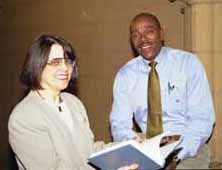A Doctoral Student and His Mentor
Terry Maltbia, who received his Ed.D. from the Adult Education Guided Intensive Study Program (AEGIS), says that it was Professor Victoria Marsick's high standards and mentorship that made his dissertation, "The Journey of the Becoming of the Diversity Practitioner: The Connection Between Experience and Learning and Confidence," distinctive.
Maltbia said that Professor Marsick was "more than a sponsor but rather a guide."
In fact, he credits Marsick with his receipt of the 2002 dissertation award from the Academy of Human Resource Development.
According to Marsick, "the 10 year-old Academy of Human Resource Development is made up of academics and others who are in practice and are interested in not just doing the latest fad, but in understanding why things do or don't work. It wants to build theories that people can use in the field and be more effective. Its interest is in improving standards in the field. I think one of the interesting points about Terry's dissertation is that frequently studies that are qualitative in nature don't get dissertation awards. Terry's dissertation won this award in spite of it's being descriptive. It is more than well done, it's systematic."
Marsick added, "Diversity is not an issue that a lot of people feel comfortable around very much. Terry's study explores what it is, in fact, that people are doing and what are the myths."
Maltbia talked about the feedback he received from the nominating committee of the Academy of Human Resource Development. "The committee members indicated," he said, "that previous studies focused on what and how something happened in diversity practice. I think that the unique contribution that this study provided is that I tried to get into the world-views of the diversity practitioner."
What are diversity practitioners?
Maltbia says they are probably as broad as the number of people who have participated in the field.
"For focus, I zeroed in on internal and external practitioners as well as a third group who worked for multiple organizations."
"Internal practitioners could be defined as those people who are diversity change agents from the CEO to first line supervisors or those who have the lead diversity job in an organization. They are either vice presidents of diversity, most times brought in for the specific purpose to initiate a company's diversity initiative or promoted internally within a company's human resources department or who are involved in a publicized class action suit, like a Texaco, or a Denny's."
"External practitioners are people who are published in refereed journals, people who are actually on the conference scene, perhaps keynote speakers at diversity conferences-whether in education or business."
"A third segment are practitioners who are working in multiple organizations who can talk about and compare and contrast the differences between approaches that work or are doing this work in multiple organizations."
What triggered Maltbia's interest in diversity practitioners?
"What piqued my interest," Maltbia said, "was a wave of articles that appeared in the business press in the middle to late 90s around the negative outcomes of diversity training. ‘White Male and Angry,' was one example, and another was ‘Where's Diversity Heading?' Although diversity was moving at a fast pace throughout the 80s and the early 90s it actually hit a turning point, almost a crisis in the middle of the 90s. I was curious about how the people who were creating this emerging field of practice were doing it without any standards. Why did they, in fact, do what they did, and how did they measure success."
"I was not only interested in what they did and how they did it, but why. What was it about their biographical experiences as individuals, their experiences in the workplace to build a model about how to approach differences productively? The dissertation dealt with not only the content of diversity and the process but also with the context. What are the things that need to be in place that would make this particular approach to diversity work in a particular organization? How can there be a transfer of practice from one setting to another and what elements would and would not work in an organization? This context and content dimension pulled the dissertation together in a comprehensive way."
How can Maltbia's dissertation be applied in the real world?
Maltbia believes his dissertation work can best be translated into a certification program. "I'd like to see programs prepare diversity practitioners in a way that's grounded and researched and again by people who either are creating the theory in the field or by those who are testing those theories outside. I'd like these programs to prepare new practitioners in the field but also as a professional development outlet for the existing practitioners."
Maltbia was the Vice President of the Organization Center of Excellence for the Stamford, Connecticut, firm for seven years and is now a consultant.
Published Thursday, Jul. 11, 2002
